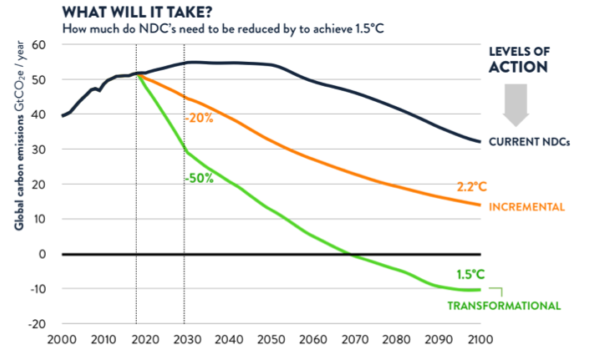How can Paris Agreement commitments be improved now to close the gap to 1.5°C
Authors
Andreas Geiges, Paola Yanguas Parra, Claire Fyson, Annika Günther, Bill Hare, Michiel Schaeffer, Ursula Fuentes Hutfilter
Share

The current level of near-term emissions reductions governments put forward in their Nationally Determined Contributions (NDCs) is not consistent with the Paris Agreement’s goal of limiting warming to 1.5°C, and puts the world on track for almost double that limit. If not enhanced, these NDCs would put the 1.5°C limit out of reach. This report looks into what level of change is needed to bring the next round of NDCs, due in 2020, in line with the Paris Agreement’s temperature goal.
Key points
The Paris Agreement requires all parties to bring forward revised and more ambitious NDCs by 2020. What level of change do we need to see by this deadline to bring the NDCs in line with the Paris Agreement’s temperature goal?
Getting NDCs in line with the 1.5°C limit requires a transformational ramping up of ambition for the period to 2030 and beyond. This means collective improvement in ambition that yields a 50% reduction from the 2030 emissions levels implied by current NDCs. This level of ambition would need to be part of long-term strategies to enable sustained emission reductions over the following decades.
All countries need to increase ambition if the 1.5°C temperature goal is to be met. All countries have an important role to play in ramping up ambition, provided that big emitters lead the way.

A 35% reduction from the 2030 emissions levels implied by current NDCs., would bring substantial progress towards closing the global ambition gap but would not meet the Paris Agreement’s long-term temperature goal. Warming would be held just below 2°C (median 1.7°C by 2100).
An incremental increase of ambition – a 20% reduction below the level implied in current 2030 NDC targets – would put the 1.5°C temperature goal out of reach. If incremental increases in ambition were continued beyond 2030, warming would reach over 2°C.
Increased transparency, clarity and integrity in the 2020 updates would make it easier to assess collective progress and identify opportunities for improvement. But increased transparency and integrity cannot be traded for increased ambition in mitigation targets – the two should come hand-in-hand.
Ignoring the need to significantly ramp up efforts now risks locking in fossil fuel-based infrastructure, thus slowing the pace of transformation and making it more costly, with a large risk of stranded assets.
There are multiple examples from around the world, as well as key market trends, show that a substantial ramping up of ambition is not only possible, but is economically beneficial and is already happening in many sectors and countries.
These include the remarkable cost decrease in renewable energy technologies since 2015, when most of the NDCs were prepared and/or submitted. Countries could achieve much higher emission reductions at the same or even lower cost than what was foreseen for their current NDCs. These cost reductions can be the springboard for transformational ambition in NDCs in 2020.
There are considerable benefits for sustainable development associated with increasing mitigation efforts and ambition consistent with the Paris Agreement. For example, shifting to renewable energy and phasing out fossil fuels can reduce air pollution and its associated health impacts, improve energy access in rural areas, and provide employment.











